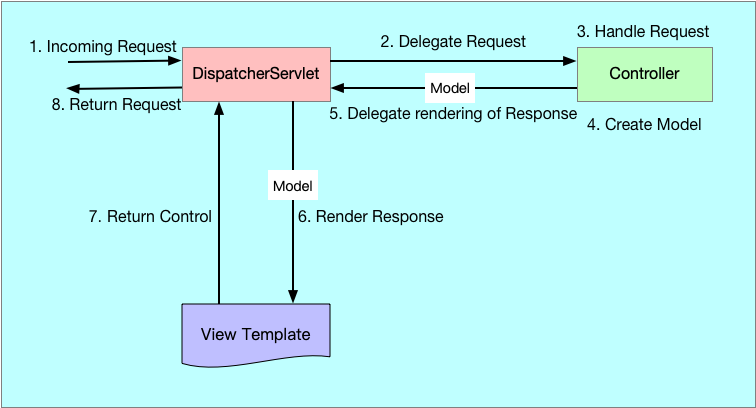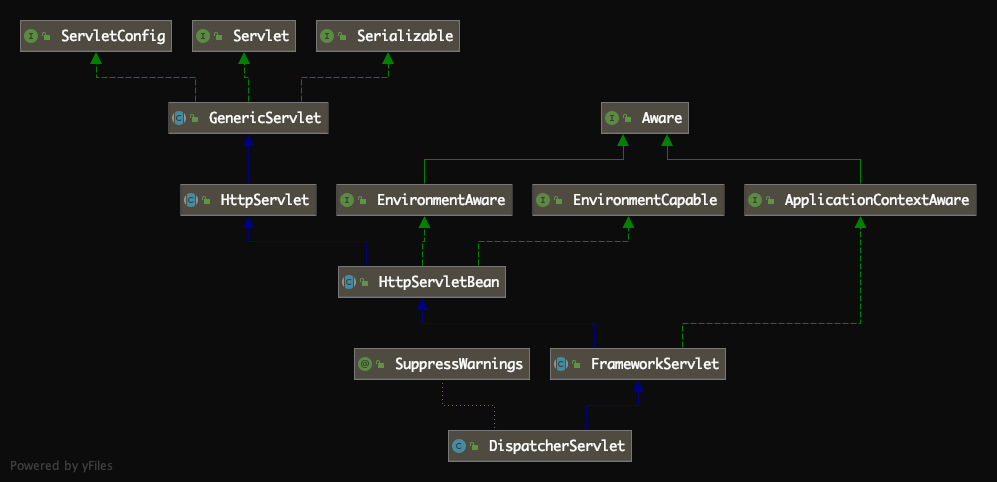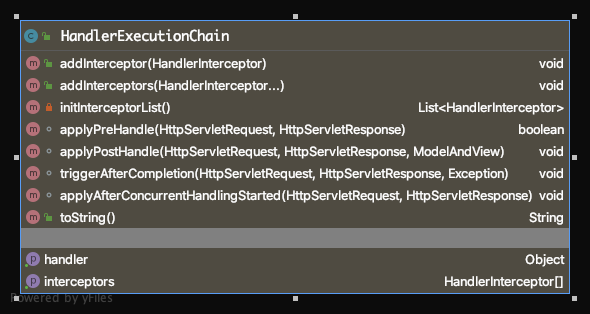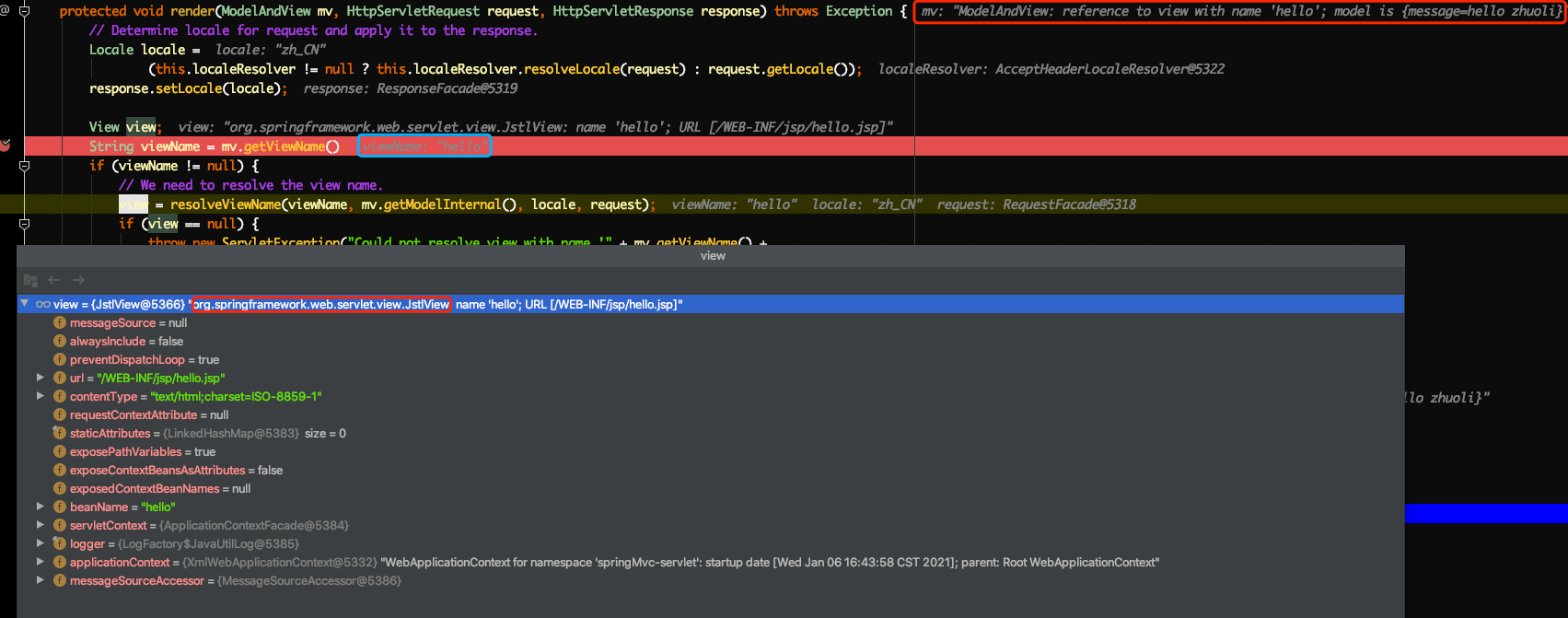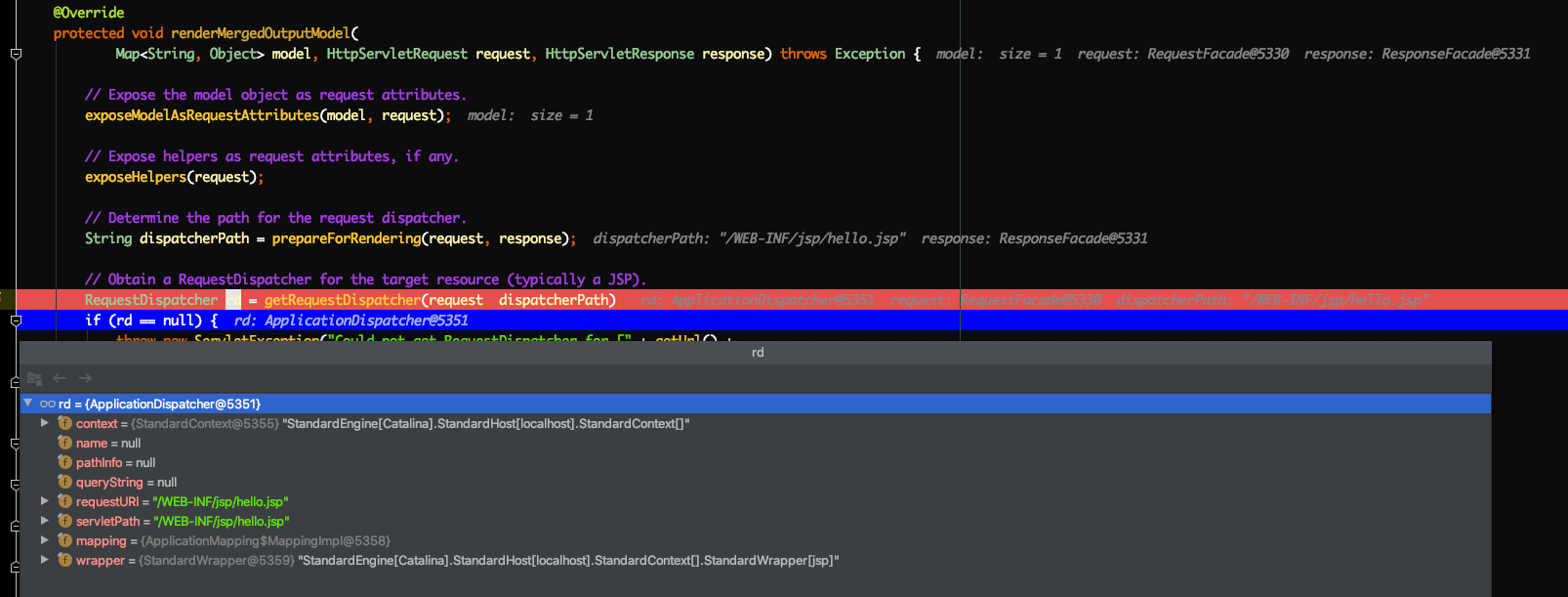上篇文章,我们介绍了Spring MVC的启动流程,介绍了一些Spring MVC的组件的启动过程。本篇文章我们就来看一下Spring MVC是如何通过这些组件来响应前端的请求的。
使用过Spring MVC开发过Java Web的同学应该都听说过一句话,Spring MVC的本质其实就是Servlet。经过之前对Tomcat和前几篇Spring MVC的介绍,相信我们都能理解这句话的意思了。这里说的Servlet其实就是指DispatcherServlet,Tomcat容器将所有请求打到DispatcherServlet,在DispatcherServlet的处理方法中,调用指定的Controller处理Web请求。
- Tomcat服务器接收到前端请求,经过Tomcat内部各个组件被转发到,被DispatcherServlet
- DispatcherServlet将请求委派给合适的处理器Controller
- Controller内部完成请求的数据模型的创建和业务逻辑的处理,然后再将填充了数据后的模型即model交还给DispatcherServlet,委派DispatcherServlet来渲染响应
- DispatcherServlet将这些数据和适当的数据模版视图结合,向Response输出响应
1. DispatcherServlet入口
DispatcherServlet本质上也是一个Servlet,DispatcherServlet继承关系如下图所示:
DispatcherServlet间接实现了抽象类HttpServlet,按照我们之前文章透过现象看本质——什么是servlet的介绍,DispatcherServlet的入口应该就在HttpServlet的service方法,子类中只要实现HttpServlet的抽象方法doGet、doPost、do**方法,就可以对外提供服务了。
其实DispatcherServlet为了支持PATCH请求,重写了HttpServlet的service方法,如下:
/**
* Override the parent class implementation in order to intercept PATCH requests.
*/
@Override
protected void service(HttpServletRequest request, HttpServletResponse response)
throws ServletException, IOException {
HttpMethod httpMethod = HttpMethod.resolve(request.getMethod());
if (httpMethod == HttpMethod.PATCH || httpMethod == null) {
processRequest(request, response);
}
else {
super.service(request, response);
}
}所以其实除了PATCH请求,其余类型的请求还跟还是通过子类重写的do**方法处理的。下面来看一下FrameworkServlet中重写的do**方法:
@Override
protected final void doGet(HttpServletRequest request, HttpServletResponse response)
throws ServletException, IOException {
processRequest(request, response);
}
@Override
protected final void doPost(HttpServletRequest request, HttpServletResponse response)
throws ServletException, IOException {
processRequest(request, response);
}
@Override
protected final void doPut(HttpServletRequest request, HttpServletResponse response)
throws ServletException, IOException {
processRequest(request, response);
}
@Override
protected final void doDelete(HttpServletRequest request, HttpServletResponse response)
throws ServletException, IOException {
processRequest(request, response);
}可以看到,最终都是通过processRequest方法处理的。
protected final void processRequest(HttpServletRequest request, HttpServletResponse response)
throws ServletException, IOException {
long startTime = System.currentTimeMillis();
Throwable failureCause = null;
LocaleContext previousLocaleContext = LocaleContextHolder.getLocaleContext();
LocaleContext localeContext = buildLocaleContext(request);
RequestAttributes previousAttributes = RequestContextHolder.getRequestAttributes();
ServletRequestAttributes requestAttributes = buildRequestAttributes(request, response, previousAttributes);
WebAsyncManager asyncManager = WebAsyncUtils.getAsyncManager(request);
asyncManager.registerCallableInterceptor(FrameworkServlet.class.getName(), new RequestBindingInterceptor());
initContextHolders(request, localeContext, requestAttributes);
try {
// doService方法,处理请求
doService(request, response);
}
catch (ServletException | IOException ex) {
failureCause = ex;
throw ex;
}
catch (Throwable ex) {
failureCause = ex;
throw new NestedServletException("Request processing failed", ex);
}
finally {
resetContextHolders(request, previousLocaleContext, previousAttributes);
if (requestAttributes != null) {
requestAttributes.requestCompleted();
}
if (logger.isDebugEnabled()) {
if (failureCause != null) {
this.logger.debug("Could not complete request", failureCause);
}
else {
if (asyncManager.isConcurrentHandlingStarted()) {
logger.debug("Leaving response open for concurrent processing");
}
else {
this.logger.debug("Successfully completed request");
}
}
}
publishRequestHandledEvent(request, response, startTime, failureCause);
}
}可以看出,processRequest方法的核心就是调用doService方法,处理请求。doService方法定义在FrameworkServlet中,是个抽象方法:
protected abstract void doService(HttpServletRequest request, HttpServletResponse response)
throws Exception;DispatcherServlet中实现了该方法。
@Override
protected void doService(HttpServletRequest request, HttpServletResponse response) throws Exception {
if (logger.isDebugEnabled()) {
String resumed = WebAsyncUtils.getAsyncManager(request).hasConcurrentResult() ? " resumed" : "";
logger.debug("DispatcherServlet with name '" + getServletName() + "'" + resumed +
" processing " + request.getMethod() + " request for [" + getRequestUri(request) + "]");
}
// Keep a snapshot of the request attributes in case of an include,
// to be able to restore the original attributes after the include.
Map<String, Object> attributesSnapshot = null;
if (WebUtils.isIncludeRequest(request)) {
attributesSnapshot = new HashMap<>();
Enumeration<?> attrNames = request.getAttributeNames();
while (attrNames.hasMoreElements()) {
String attrName = (String) attrNames.nextElement();
if (this.cleanupAfterInclude || attrName.startsWith(DEFAULT_STRATEGIES_PREFIX)) {
attributesSnapshot.put(attrName, request.getAttribute(attrName));
}
}
}
// 将子容器和一些DispatcherServlet 成员设置到HttpServletRequest的attribute中,以便后面的流程中使用
request.setAttribute(WEB_APPLICATION_CONTEXT_ATTRIBUTE, getWebApplicationContext());
request.setAttribute(LOCALE_RESOLVER_ATTRIBUTE, this.localeResolver);
request.setAttribute(THEME_RESOLVER_ATTRIBUTE, this.themeResolver);
request.setAttribute(THEME_SOURCE_ATTRIBUTE, getThemeSource());
if (this.flashMapManager != null) {
FlashMap inputFlashMap = this.flashMapManager.retrieveAndUpdate(request, response);
if (inputFlashMap != null) {
request.setAttribute(INPUT_FLASH_MAP_ATTRIBUTE, Collections.unmodifiableMap(inputFlashMap));
}
request.setAttribute(OUTPUT_FLASH_MAP_ATTRIBUTE, new FlashMap());
request.setAttribute(FLASH_MAP_MANAGER_ATTRIBUTE, this.flashMapManager);
}
try {
// 请求分发,在该方法中,调用具体的Controller处理请求
doDispatch(request, response);
}
finally {
if (!WebAsyncUtils.getAsyncManager(request).isConcurrentHandlingStarted()) {
// Restore the original attribute snapshot, in case of an include.
if (attributesSnapshot != null) {
restoreAttributesAfterInclude(request, attributesSnapshot);
}
}
}
}核心逻辑其实就是调用doDispatch方法,处理请求,这个方法也是DispatcherServlet处理外部请求的核心方法。
protected void doDispatch(HttpServletRequest request, HttpServletResponse response) throws Exception {
HttpServletRequest processedRequest = request;
HandlerExecutionChain mappedHandler = null;
boolean multipartRequestParsed = false;
WebAsyncManager asyncManager = WebAsyncUtils.getAsyncManager(request);
try {
ModelAndView mv = null;
Exception dispatchException = null;
try {
processedRequest = checkMultipart(request);
multipartRequestParsed = (processedRequest != request);
// 1. 获取HandlerExecutionChain
mappedHandler = getHandler(processedRequest);
if (mappedHandler == null) {
noHandlerFound(processedRequest, response);
return;
}
// 2. 获取HandlerAdapter
HandlerAdapter ha = getHandlerAdapter(mappedHandler.getHandler());
// Process last-modified header, if supported by the handler.
String method = request.getMethod();
boolean isGet = "GET".equals(method);
if (isGet || "HEAD".equals(method)) {
long lastModified = ha.getLastModified(request, mappedHandler.getHandler());
if (logger.isDebugEnabled()) {
logger.debug("Last-Modified value for [" + getRequestUri(request) + "] is: " + lastModified);
}
if (new ServletWebRequest(request, response).checkNotModified(lastModified) && isGet) {
return;
}
}
// 3. 调用HandlerExecutionChain的applyPreHandle,用于执行Spring MVC拦截器的前置处理
if (!mappedHandler.applyPreHandle(processedRequest, response)) {
return;
}
// 4. 调用HandlerAdapter的handle方法,调用具体的Controller的method
mv = ha.handle(processedRequest, response, mappedHandler.getHandler());
if (asyncManager.isConcurrentHandlingStarted()) {
return;
}
// 5. 对Controller方法返回的ModelAndView,设置默认视图名
applyDefaultViewName(processedRequest, mv);
// 6. 调用HandlerExecutionChain的applyPostHandle,用于执行Spring MVC拦截器的后置处理
mappedHandler.applyPostHandle(processedRequest, response, mv);
}
catch (Exception ex) {
dispatchException = ex;
}
catch (Throwable err) {
// As of 4.3, we're processing Errors thrown from handler methods as well,
// making them available for @ExceptionHandler methods and other scenarios.
dispatchException = new NestedServletException("Handler dispatch failed", err);
}
// 7. 视图渲染
processDispatchResult(processedRequest, response, mappedHandler, mv, dispatchException);
}
catch (Exception ex) {
triggerAfterCompletion(processedRequest, response, mappedHandler, ex);
}
catch (Throwable err) {
triggerAfterCompletion(processedRequest, response, mappedHandler,
new NestedServletException("Handler processing failed", err));
}
finally {
if (asyncManager.isConcurrentHandlingStarted()) {
// Instead of postHandle and afterCompletion
if (mappedHandler != null) {
mappedHandler.applyAfterConcurrentHandlingStarted(processedRequest, response);
}
}
else {
// Clean up any resources used by a multipart request.
if (multipartRequestParsed) {
cleanupMultipart(processedRequest);
}
}
}
}核心流程,在上述方法中都已经标注出来,接下来我们来分析一下上述核心流程。
2. getHandler
org.springframework.web.servlet.DispatcherServlet#getHandler方法返回值类型为HandlerExecutionChain。
protected HandlerExecutionChain getHandler(HttpServletRequest request) throws Exception {
if (this.handlerMappings != null) {
for (HandlerMapping hm : this.handlerMappings) {
if (logger.isTraceEnabled()) {
logger.trace(
"Testing handler map [" + hm + "] in DispatcherServlet with name '" + getServletName() + "'");
}
HandlerExecutionChain handler = hm.getHandler(request);
if (handler != null) {
return handler;
}
}
}
return null;
}在该方法中,其实就是遍历所有的DispatcherServlet的成员变量handlerMappings(handlerMappings的初始化上篇文章中已经介绍了),调用HandlerMapping的getHandler方法,如果任意一个HandlerMapping的getHandler方法返回了结果,就不继续往下遍历了。
HandlerMapping的getHandler方法,定义在HandlerMapping接口,实现在AbstractHandlerMapping抽象类中:
public final HandlerExecutionChain getHandler(HttpServletRequest request) throws Exception {
// 1. 根据request获取Handler,如果HandlerMapping类型为RequestMappingHandlerMapping,则该方法返回值类型为HandlerMethod
Object handler = getHandlerInternal(request);
// 2. 如果上述方法获取不到handler,则调用getDefaultHandler方法,获取默认Handler
if (handler == null) {
handler = getDefaultHandler();
}
if (handler == null) {
return null;
}
// 3. 如果返回的handler类型为String,则使用Spring容器实例化handler
if (handler instanceof String) {
String handlerName = (String) handler;
handler = obtainApplicationContext().getBean(handlerName);
}
// 4. 查询本次请求匹配的Spring MVC拦截器,和handler一起组装生成HandlerExecutionChain
HandlerExecutionChain executionChain = getHandlerExecutionChain(handler, request);
if (CorsUtils.isCorsRequest(request)) {
CorsConfiguration globalConfig = this.globalCorsConfigSource.getCorsConfiguration(request);
CorsConfiguration handlerConfig = getCorsConfiguration(handler, request);
CorsConfiguration config = (globalConfig != null ? globalConfig.combine(handlerConfig) : handlerConfig);
executionChain = getCorsHandlerExecutionChain(request, executionChain, config);
}
return executionChain;
}2.1 getHandlerInternal
org.springframework.web.servlet.handler.AbstractHandlerMapping#getHandlerInternal方法,是个抽象方法,由子类实现。我们上篇文章介绍Spring MVC启动过程时介绍过,DispatcherServlet的成员变量handlerMappings,第一个元素的类型为RequestMappingHandlerMapping,所以在该类中查找getHandlerInternal,发现RequestMappingHandlerMapping对该方法的实现定义在父类AbstractHandlerMethodMapping中:
protected HandlerMethod getHandlerInternal(HttpServletRequest request) throws Exception {
// 1. 从request获取url
String lookupPath = getUrlPathHelper().getLookupPathForRequest(request);
if (logger.isDebugEnabled()) {
logger.debug("Looking up handler method for path " + lookupPath);
}
this.mappingRegistry.acquireReadLock();
try {
// 2. 根据rul,查询匹配的HandlerMethod
HandlerMethod handlerMethod = lookupHandlerMethod(lookupPath, request);
if (logger.isDebugEnabled()) {
if (handlerMethod != null) {
logger.debug("Returning handler method [" + handlerMethod + "]");
}
else {
logger.debug("Did not find handler method for [" + lookupPath + "]");
}
}
return (handlerMethod != null ? handlerMethod.createWithResolvedBean() : null);
}
finally {
this.mappingRegistry.releaseReadLock();
}
}可以看到getHandlerInternal方法返回值类型为HandlerMethod,对应于Controller中的某一个方法。上篇文章中也介绍过,在AbstractHandlerMethodMapping中有一个MappingRegistry类型的成员mappingRegistry,统一管理URL和HandlerMethod的映射关系,lookupHandlerMethod就是根据URL从mappingRegistry中匹配HandlerMethod。
protected HandlerMethod lookupHandlerMethod(String lookupPath, HttpServletRequest request) throws Exception {
List<Match> matches = new ArrayList<>();
// 1. 根据URL,从mappingRegistry获取匹配到的RequestMappingInfo
List<T> directPathMatches = this.mappingRegistry.getMappingsByUrl(lookupPath);
if (directPathMatches != null) {
addMatchingMappings(directPathMatches, matches, request);
}
if (matches.isEmpty()) {
// No choice but to go through all mappings...
addMatchingMappings(this.mappingRegistry.getMappings().keySet(), matches, request);
}
// 2. 对匹配项进行排序,寻找最匹配的HandlerMethod
if (!matches.isEmpty()) {
Comparator<Match> comparator = new MatchComparator(getMappingComparator(request));
matches.sort(comparator);
if (logger.isTraceEnabled()) {
logger.trace("Found " + matches.size() + " matching mapping(s) for [" + lookupPath + "] : " + matches);
}
Match bestMatch = matches.get(0);
if (matches.size() > 1) {
if (CorsUtils.isPreFlightRequest(request)) {
return PREFLIGHT_AMBIGUOUS_MATCH;
}
Match secondBestMatch = matches.get(1);
if (comparator.compare(bestMatch, secondBestMatch) == 0) {
Method m1 = bestMatch.handlerMethod.getMethod();
Method m2 = secondBestMatch.handlerMethod.getMethod();
throw new IllegalStateException("Ambiguous handler methods mapped for HTTP path '" +
request.getRequestURL() + "': {" + m1 + ", " + m2 + "}");
}
}
handleMatch(bestMatch.mapping, lookupPath, request);
return bestMatch.handlerMethod;
}
else {
return handleNoMatch(this.mappingRegistry.getMappings().keySet(), lookupPath, request);
}
}2.2 HandlerExecutionChain
上述步骤,我们根据URL获取了对应处理的HandlerMethod(某个Controller的方法),getHandler方法的最终返回结果HandlerExecutionChain,通过调用getHandlerExecutionChain方法获取。
protected HandlerExecutionChain getHandlerExecutionChain(Object handler, HttpServletRequest request) {
// 1. 初始化HandlerExecutionChain
HandlerExecutionChain chain = (handler instanceof HandlerExecutionChain ?
(HandlerExecutionChain) handler : new HandlerExecutionChain(handler));
// 2. 为当前请求对应的HandlerExecutionChain,添加HandlerInterceptor
String lookupPath = this.urlPathHelper.getLookupPathForRequest(request);
for (HandlerInterceptor interceptor : this.adaptedInterceptors) {
if (interceptor instanceof MappedInterceptor) {
MappedInterceptor mappedInterceptor = (MappedInterceptor) interceptor;
if (mappedInterceptor.matches(lookupPath, this.pathMatcher)) {
chain.addInterceptor(mappedInterceptor.getInterceptor());
}
}
else {
chain.addInterceptor(interceptor);
}
}
return chain;
}所以其实不难发现,HandlerExecutionChain其实就是Handler(HandlerMethod)和Interceptor的组合。
所以获取到HandlerExecutionChain,也就意味着当前请求已经定位到一个Controller对应的Method,并且该请求需要应用的拦截器也已经确定了。
其中拦截器可以在Controller的Method执行前后,做一些前置和后置操作,类似于AOP的环绕通知。
3. HandlerAdapter
接下来,我们继续来看DispatcherServlet类的doDispatch方法中获取HandlerAdapter的逻辑,getHandlerAdapter方法。
上篇文章介绍过,HandlerAdapter其实就是用于维护一些参数解析器以及返回值解析器。
protected HandlerAdapter getHandlerAdapter(Object handler) throws ServletException {
// 遍历handlerAdapters,返回支持当前HandlerMethod的HandlerAdapter
if (this.handlerAdapters != null) {
for (HandlerAdapter ha : this.handlerAdapters) {
if (logger.isTraceEnabled()) {
logger.trace("Testing handler adapter [" + ha + "]");
}
if (ha.supports(handler)) {
return ha;
}
}
}
throw new ServletException("No adapter for handler [" + handler +
"]: The DispatcherServlet configuration needs to include a HandlerAdapter that supports this handler");
}getHandlerAdapter方法逻辑也比较简单,就是遍历DispatcherServlet的成员变量,返回支持当前HandlerMethod的HandlerAdapter。
DispatcherServlet成员变量handlerAdapters的初始化,上篇文章已经介绍过。我们知道,handlerAdapters第一个元素类型为RequestMappingHandlerAdapter,我们来继续跟进看一下RequestMappingHandlerAdapter的supports方法:
public final boolean supports(Object handler) {
return (handler instanceof HandlerMethod && supportsInternal((HandlerMethod) handler));
}
@Override
protected boolean supportsInternal(HandlerMethod handlerMethod) {
return true;
}所以这里getHandlerAdapter方法,会返回一个RequestMappingHandlerAdapter类型的对象。
4. HandlerExecutionChain,拦截器处理
上面说过HandlerExecutionChain是HandlerMethod和HandlerInterceptor的集合。HandlerInterceptor接口定义如下:
public interface HandlerInterceptor {
default boolean preHandle(HttpServletRequest request, HttpServletResponse response, Object handler)
throws Exception {
return true;
}
default void postHandle(HttpServletRequest request, HttpServletResponse response, Object handler,
@Nullable ModelAndView modelAndView) throws Exception {
}
default void afterCompletion(HttpServletRequest request, HttpServletResponse response, Object handler,
@Nullable Exception ex) throws Exception {
}
}- preHandle:在HandlerMethod对应的方法执行前调用,前置拦截
- postHandle:在HandlerMethod对应的方法执行后,视图渲染前拦截调用
- afterCompletion:请求处理完成,视图渲染后调用
所以HandlerExecutionChain一个重要的功能就是执行拦截器的逻辑,HandlerExecutionChain中定义了三个跟拦截器执行相关的方法:
- applyPreHandle:执行当前请求所有拦截器preHandle拦截方法,如果任何一个拦截器返回false,表示当前请求被拦截,后面的拦截器就不用继续执行了(当前请求到此结束)
- applyPostHandle:执行当前请求所有拦截器的postHandle方法
- triggerAfterCompletion:执行当前请求所有拦截器的afterCompletion方法
boolean applyPreHandle(HttpServletRequest request, HttpServletResponse response) throws Exception {
HandlerInterceptor[] interceptors = getInterceptors();
if (!ObjectUtils.isEmpty(interceptors)) {
for (int i = 0; i < interceptors.length; i++) {
// 遍历interceptors,执行每一个HandlerInterceptor的preHandle方法,
// 如果返回true,执行下一个拦截器的拦截逻辑。如果返回false,当前请求被拦截,返回false,当前请求就不会继续被处理了
HandlerInterceptor interceptor = interceptors[i];
if (!interceptor.preHandle(request, response, this.handler)) {
triggerAfterCompletion(request, response, null);
return false;
}
this.interceptorIndex = i;
}
}
return true;
}void applyPostHandle(HttpServletRequest request, HttpServletResponse response, @Nullable ModelAndView mv)
throws Exception {
HandlerInterceptor[] interceptors = getInterceptors();
if (!ObjectUtils.isEmpty(interceptors)) {
// 遍历所有拦截器,执行postHandle方法
for (int i = interceptors.length - 1; i >= 0; i--) {
HandlerInterceptor interceptor = interceptors[i];
interceptor.postHandle(request, response, this.handler, mv);
}
}
}void triggerAfterCompletion(HttpServletRequest request, HttpServletResponse response, @Nullable Exception ex)
throws Exception {
HandlerInterceptor[] interceptors = getInterceptors();
if (!ObjectUtils.isEmpty(interceptors)) {
// 遍历所有拦截器,执行拦截器afterCompletion方法
for (int i = this.interceptorIndex; i >= 0; i--) {
HandlerInterceptor interceptor = interceptors[i];
try {
interceptor.afterCompletion(request, response, this.handler, ex);
}
catch (Throwable ex2) {
logger.error("HandlerInterceptor.afterCompletion threw exception", ex2);
}
}
}
}5. HandlerAdapter.handle处理请求
接下来,我们来看一下Spring MVC处理请求的核心流程,就是Controller的方法是怎么被调用的,并且结果是怎么处理的。入口其实就在HandlerAdapter的handle方法。
handle方法,定义在RequestMappingHandlerAdapter的父类AbstractHandlerMethodAdapter中。如下:
public final ModelAndView handle(HttpServletRequest request, HttpServletResponse response, Object handler)
throws Exception {
return handleInternal(request, response, (HandlerMethod) handler);
}
protected abstract ModelAndView handleInternal(HttpServletRequest request,
HttpServletResponse response, HandlerMethod handlerMethod) throws Exception;handle方法内,直接调用了handleInternal方法,handleInternal方法在AbstractHandlerMethodAdapter中定义为抽象方法,子类RequestMappingHandlerAdapter实现了该方法:
protected ModelAndView handleInternal(HttpServletRequest request,
HttpServletResponse response, HandlerMethod handlerMethod) throws Exception {
ModelAndView mav;
checkRequest(request);
// 执行HandlerMethod
if (this.synchronizeOnSession) {
HttpSession session = request.getSession(false);
if (session != null) {
Object mutex = WebUtils.getSessionMutex(session);
synchronized (mutex) {
mav = invokeHandlerMethod(request, response, handlerMethod);
}
}
else {
// No HttpSession available -> no mutex necessary
mav = invokeHandlerMethod(request, response, handlerMethod);
}
}
else {
// No synchronization on session demanded at all...
mav = invokeHandlerMethod(request, response, handlerMethod);
}
if (!response.containsHeader(HEADER_CACHE_CONTROL)) {
if (getSessionAttributesHandler(handlerMethod).hasSessionAttributes()) {
applyCacheSeconds(response, this.cacheSecondsForSessionAttributeHandlers);
}
else {
prepareResponse(response);
}
}
return mav;
}可以确定,handleInternal方法,调用了invokeHandlerMethod方法来执行HandlerMethod。
protected ModelAndView invokeHandlerMethod(HttpServletRequest request,
HttpServletResponse response, HandlerMethod handlerMethod) throws Exception {
ServletWebRequest webRequest = new ServletWebRequest(request, response);
try {
WebDataBinderFactory binderFactory = getDataBinderFactory(handlerMethod);
ModelFactory modelFactory = getModelFactory(handlerMethod, binderFactory);
// 1. 基于HandlerMethod,包装ServletInvocableHandlerMethod,
// 包含了HandlerMethod、ArgumentResolver、ReturnValueHandler、DataBinderFactory等
ServletInvocableHandlerMethod invocableMethod = createInvocableHandlerMethod(handlerMethod);
if (this.argumentResolvers != null) {
invocableMethod.setHandlerMethodArgumentResolvers(this.argumentResolvers);
}
if (this.returnValueHandlers != null) {
invocableMethod.setHandlerMethodReturnValueHandlers(this.returnValueHandlers);
}
invocableMethod.setDataBinderFactory(binderFactory);
invocableMethod.setParameterNameDiscoverer(this.parameterNameDiscoverer);
// 2. 初始化ModelAndViewContainer
ModelAndViewContainer mavContainer = new ModelAndViewContainer();
mavContainer.addAllAttributes(RequestContextUtils.getInputFlashMap(request));
modelFactory.initModel(webRequest, mavContainer, invocableMethod);
mavContainer.setIgnoreDefaultModelOnRedirect(this.ignoreDefaultModelOnRedirect);
// 3. 异步请求处理
AsyncWebRequest asyncWebRequest = WebAsyncUtils.createAsyncWebRequest(request, response);
asyncWebRequest.setTimeout(this.asyncRequestTimeout);
WebAsyncManager asyncManager = WebAsyncUtils.getAsyncManager(request);
asyncManager.setTaskExecutor(this.taskExecutor);
asyncManager.setAsyncWebRequest(asyncWebRequest);
asyncManager.registerCallableInterceptors(this.callableInterceptors);
asyncManager.registerDeferredResultInterceptors(this.deferredResultInterceptors);
if (asyncManager.hasConcurrentResult()) {
Object result = asyncManager.getConcurrentResult();
mavContainer = (ModelAndViewContainer) asyncManager.getConcurrentResultContext()[0];
asyncManager.clearConcurrentResult();
if (logger.isDebugEnabled()) {
logger.debug("Found concurrent result value [" + result + "]");
}
invocableMethod = invocableMethod.wrapConcurrentResult(result);
}
// 4. 处理请求
invocableMethod.invokeAndHandle(webRequest, mavContainer);
if (asyncManager.isConcurrentHandlingStarted()) {
return null;
}
// 5. 封装数据和视图,返回ModelAndView
return getModelAndView(mavContainer, modelFactory, webRequest);
}
finally {
webRequest.requestCompleted();
}
}继续跟一下核心流程invokeAndHandle方法:
public void invokeAndHandle(ServletWebRequest webRequest, ModelAndViewContainer mavContainer,
Object... providedArgs) throws Exception {
// 1. 执行请求
Object returnValue = invokeForRequest(webRequest, mavContainer, providedArgs);
setResponseStatus(webRequest);
if (returnValue == null) {
if (isRequestNotModified(webRequest) || getResponseStatus() != null || mavContainer.isRequestHandled()) {
mavContainer.setRequestHandled(true);
return;
}
}
else if (StringUtils.hasText(getResponseStatusReason())) {
mavContainer.setRequestHandled(true);
return;
}
mavContainer.setRequestHandled(false);
Assert.state(this.returnValueHandlers != null, "No return value handlers");
try {
// 返回值处理
this.returnValueHandlers.handleReturnValue(
returnValue, getReturnValueType(returnValue), mavContainer, webRequest);
}
catch (Exception ex) {
if (logger.isTraceEnabled()) {
logger.trace(getReturnValueHandlingErrorMessage("Error handling return value", returnValue), ex);
}
throw ex;
}
}public Object invokeForRequest(NativeWebRequest request, @Nullable ModelAndViewContainer mavContainer,
Object... providedArgs) throws Exception {
// 1. 获取方法实参列表
Object[] args = getMethodArgumentValues(request, mavContainer, providedArgs);
if (logger.isTraceEnabled()) {
logger.trace("Invoking '" + ClassUtils.getQualifiedMethodName(getMethod(), getBeanType()) +
"' with arguments " + Arrays.toString(args));
}
// 2. 反射Controller方法,获取方法返回值
Object returnValue = doInvoke(args);
if (logger.isTraceEnabled()) {
logger.trace("Method [" + ClassUtils.getQualifiedMethodName(getMethod(), getBeanType()) +
"] returned [" + returnValue + "]");
}
return returnValue;
}关于获取方法的实参列表,这里就不继续跟进分析了,就是使用RequestMappingHandlerAdapter的成员变量argumentResolvers去解析。反射方法也比较简单,不详细介绍了。
invokeAndHandle方法第2步,返回值处理:
this.returnValueHandlers.handleReturnValue(returnValue, getReturnValueType(returnValue), mavContainer, webRequest);其实也是使用RequestMappingHandlerAdapter的成员变量returnValueHandlers来处理返回值,根据返回值类型,挑选一个合适的HandlerMethodReturnValueHandler来处理返回值。
public void handleReturnValue(@Nullable Object returnValue, MethodParameter returnType,
ModelAndViewContainer mavContainer, NativeWebRequest webRequest) throws Exception {
HandlerMethodReturnValueHandler handler = selectHandler(returnValue, returnType);
if (handler == null) {
throw new IllegalArgumentException("Unknown return value type: " + returnType.getParameterType().getName());
}
handler.handleReturnValue(returnValue, returnType, mavContainer, webRequest);
}invokeHandlerMethod方法最后,调用了getModelAndView,封装数据和和视图,返回ModelAndView。
private ModelAndView getModelAndView(ModelAndViewContainer mavContainer,
ModelFactory modelFactory, NativeWebRequest webRequest) throws Exception {
modelFactory.updateModel(webRequest, mavContainer);
if (mavContainer.isRequestHandled()) {
return null;
}
ModelMap model = mavContainer.getModel();
ModelAndView mav = new ModelAndView(mavContainer.getViewName(), model, mavContainer.getStatus());
if (!mavContainer.isViewReference()) {
mav.setView((View) mavContainer.getView());
}
if (model instanceof RedirectAttributes) {
Map<String, ?> flashAttributes = ((RedirectAttributes) model).getFlashAttributes();
HttpServletRequest request = webRequest.getNativeRequest(HttpServletRequest.class);
if (request != null) {
RequestContextUtils.getOutputFlashMap(request).putAll(flashAttributes);
}
}
return mav;
}其中ModelMap,其实就是Controller方法的返回值,只不过通过ReturnValueHandler处理后,转化成了ModelMap,其实ModelMap就是一个Map。
6. processDispatchResult视图渲染
接下来看一下doDispatch方法的最后一个关键步骤,调用processDispatchResult进行视图渲染。
private void processDispatchResult(HttpServletRequest request, HttpServletResponse response,
@Nullable HandlerExecutionChain mappedHandler, @Nullable ModelAndView mv,
@Nullable Exception exception) throws Exception {
boolean errorView = false;
// 异常处理
if (exception != null) {
if (exception instanceof ModelAndViewDefiningException) {
logger.debug("ModelAndViewDefiningException encountered", exception);
mv = ((ModelAndViewDefiningException) exception).getModelAndView();
}
else {
Object handler = (mappedHandler != null ? mappedHandler.getHandler() : null);
mv = processHandlerException(request, response, handler, exception);
errorView = (mv != null);
}
}
if (mv != null && !mv.wasCleared()) {
// 视图渲染
render(mv, request, response);
if (errorView) {
WebUtils.clearErrorRequestAttributes(request);
}
}
else {
if (logger.isDebugEnabled()) {
logger.debug("Null ModelAndView returned to DispatcherServlet with name '" + getServletName() +
"': assuming HandlerAdapter completed request handling");
}
}
if (WebAsyncUtils.getAsyncManager(request).isConcurrentHandlingStarted()) {
// Concurrent handling started during a forward
return;
}
// 视图渲染后,执行拦截器的afterCompletion方法
if (mappedHandler != null) {
mappedHandler.triggerAfterCompletion(request, response, null);
}
}protected void render(ModelAndView mv, HttpServletRequest request, HttpServletResponse response) throws Exception {
// Determine locale for request and apply it to the response.
Locale locale =
(this.localeResolver != null ? this.localeResolver.resolveLocale(request) : request.getLocale());
response.setLocale(locale);
// 1. 构建View
View view;
String viewName = mv.getViewName();
if (viewName != null) {
// We need to resolve the view name.
view = resolveViewName(viewName, mv.getModelInternal(), locale, request);
if (view == null) {
throw new ServletException("Could not resolve view with name '" + mv.getViewName() +
"' in servlet with name '" + getServletName() + "'");
}
}
else {
// No need to lookup: the ModelAndView object contains the actual View object.
view = mv.getView();
if (view == null) {
throw new ServletException("ModelAndView [" + mv + "] neither contains a view name nor a " +
"View object in servlet with name '" + getServletName() + "'");
}
}
// Delegate to the View object for rendering.
if (logger.isDebugEnabled()) {
logger.debug("Rendering view [" + view + "] in DispatcherServlet with name '" + getServletName() + "'");
}
try {
if (mv.getStatus() != null) {
response.setStatus(mv.getStatus().value());
}
// 2. 调用View的render方法渲染视图
view.render(mv.getModelInternal(), request, response);
}
catch (Exception ex) {
if (logger.isDebugEnabled()) {
logger.debug("Error rendering view [" + view + "] in DispatcherServlet with name '" +
getServletName() + "'", ex);
}
throw ex;
}
}可以看出,这里根据ModelAndView构建出一个View对象,类型为JstlView。所以接下来继续看一下JstlView的render方法。该方法定义在父类AbstractView中:
public void render(@Nullable Map<String, ?> model, HttpServletRequest request,
HttpServletResponse response) throws Exception {
if (logger.isTraceEnabled()) {
logger.trace("Rendering view with name '" + this.beanName + "' with model " + model +
" and static attributes " + this.staticAttributes);
}
// 组装数据
Map<String, Object> mergedModel = createMergedOutputModel(model, request, response);
prepareResponse(request, response);
// 渲染输出
renderMergedOutputModel(mergedModel, getRequestToExpose(request), response);
}renderMergedOutputModel方法也定义在JstlView的父类,InternalResourceView。
protected void renderMergedOutputModel(
Map<String, Object> model, HttpServletRequest request, HttpServletResponse response) throws Exception {
// 将返回值,设置为Request的attribute
exposeModelAsRequestAttributes(model, request);
// Expose helpers as request attributes, if any.
exposeHelpers(request);
// 获取跳转的路径
String dispatcherPath = prepareForRendering(request, response);
// Obtain a RequestDispatcher for the target resource (typically a JSP).
RequestDispatcher rd = getRequestDispatcher(request, dispatcherPath);
if (rd == null) {
throw new ServletException("Could not get RequestDispatcher for [" + getUrl() +
"]: Check that the corresponding file exists within your web application archive!");
}
// If already included or response already committed, perform include, else forward.
if (useInclude(request, response)) {
response.setContentType(getContentType());
if (logger.isDebugEnabled()) {
logger.debug("Including resource [" + getUrl() + "] in InternalResourceView '" + getBeanName() + "'");
}
rd.include(request, response);
}
else {
// Note: The forwarded resource is supposed to determine the content type itself.
if (logger.isDebugEnabled()) {
logger.debug("Forwarding to resource [" + getUrl() + "] in InternalResourceView '" + getBeanName() + "'");
}
// 跳转,比如到Jsp
rd.forward(request, response);
}
}假如我们的目标地址是个jsp页面,其实就是跳转到另一个Servlet,Jsp对应的Servlet处理完后,就能输出Http内容了,再之后就是Tomcat容器要做的工作了。
参考链接:
1. SpringMVC 源码
 Zhuoli's Blog
Zhuoli's Blog